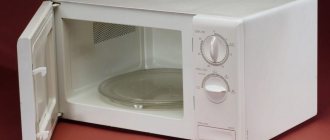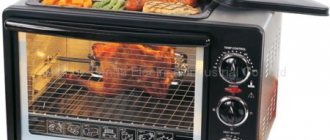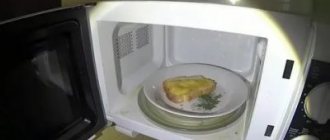Today, almost every home has a microwave, which is used to heat food, prepare hot sandwiches for breakfast, and heat milk formula for small children. Microwave ovens produce a humming and slight noise during operation. But when the noise becomes too strong, it is a signal to users that something is going wrong. Let's figure out why the microwave can make a loud noise when it's running.
Causes of abnormal humming in a microwave oven
There can be many reasons why a microwave starts humming. Regardless of the level of complexity of the breakdown, the device must be repaired or serviced as quickly as possible. If this is not done, even a small problem can cause serious problems and increase the cost of repairs.
The tray is slipping
This most often occurs due to lack of maintenance. Namely: food residues accumulate under the tray and the plate becomes wedged. As a result, the engine experiences heavy loads and may slip. This leads to overheating and wear. The microwave needs to be cleaned.
If this does not help, you will have to check the condition of the drive system. To do this, remove the casing and the lower part of the pan.
Broken fan
Most often this happens due to wear on the bushing. This happens quite quickly in inexpensive microwave ovens. This problem is even more pronounced in models that have a common sump and fan motor. The air blowing and circulation system needs to be checked.
Magnetron problems
When the emitting lamp completely fails, the microwave makes a loud hum and does not heat. Magnetron failure is dangerous. Microwaves with this problem often spark. The magnetron should be checked.
It is recommended to entrust this work to specialists. Home craftsmen with skills in handling measuring instruments should look for the characteristics of a specific magnetron model on the Internet.
The emitter is most often beyond repair. It is completely changed. You can buy a new magnetron on the Internet. However, its cost is often comparable to a new microwave. Therefore, if testing shows a breakdown, you should consider whether repairs need to be made. After all, buying a new microwave oven is guaranteed to eliminate possible causes of magnetron failure.
Capacitor breakdown or change in its parameters
In this case, the microwave makes strange sounds. You can check the capacity of this part using a conventional multimeter. But before testing, the capacitor must be completely discharged. If the body does not ring when measuring parameters, it means that this part needs to be changed.
High voltage diode failure
When such a breakdown occurs, the microwave makes squeaks, whistles and heats up the heat exchanger. The repair is simple: the diode is checked with a multimeter and replaced if necessary. If the part is working normally, it does not ring at 9V.
Repair stages
After making sure that the microwave is not working, unscrew the bolts on the casing from the rear wall. Carefully remove the housing.
First make sure the fuse is working properly. This will reveal, once removed, a thin wire inside. If it burns out, install a new one.
Also check the condition of the electronics circuit guard. To do this, open the container and inspect the filament. If necessary, install new protection. Do not use bugs under any circumstances. Is it dangerous.
Now switch the multimeter from standby mode to dial-in mode. We bring one probe to a contact, for example a diode, and touch the ground with the second. The “broken” part will respond with a squeak. A working one will not show anything. Now we disconnect and replace the diode with similar parameters and check again.
We do the same with the capacitor, not forgetting to discharge and check it.
The question with the magnetron is more complicated. Its power is about 800 watts. It is this that generates the waves that produce heat. Therefore it is protected by a plate radiator and a thermal fuse. Determining its serviceability and the need for replacement is the job of a specialist from the workshop. You can only inspect the part for carbon deposits or obvious damage.
We hope our tips will help home DIYers if their oven is humming, knocking, whistling or squeaking, or when the microwave is not working at all. Happy renovation!
Most homes have a microwave. When working, this technique always makes sounds. But if the noise gets louder, it means something is not working correctly. Let's figure out why the device may crackle or make noise.
How to diagnose
The initial microwave check can be considered standard. The device is partially disassembled. To do this, unscrew the screws on the back cover and remove the casing. The insides of the device are carefully inspected. A search is underway for melting zones, parts and contact areas with carbon deposits. The soldering points of the wires and the condition of the latter are inspected very carefully.
Then the main fuse is examined. Its body is transparent. If the fuse works, the broken thread inside will be visible visually. The part needs to be replaced. But if the fuse blows again when turned on, testing continues.
For the further diagnostic process, you will need a tester. All parts on the magnetron board are checked. Dialing can be done without soldering the elements. If units are found with parameters that do not correspond to the circuit diagram, they are replaced. The board testing ends by checking the thermal fuse. In normal condition, its resistance should be zero.
It is not possible to check the power diode with home appliances. It is connected to a 220V network. One end directly to the power wire, the other to the second with the tester connected in series. If the latter shows voltage at one or another position of the diode, it means it is working. Otherwise, the part must be replaced.
If it is impossible to find a product with the same rating, it is permissible to use a 5 kV diode with a current of 700 mA.
The magnetron is tested in several stages.
- Filament. Its resistance is within 10 ohms.
- If the tester shows infinity when checking the filament, it is worth opening the case and checking the reliability of the connection of the terminals and conductors of the inductors.
- The resistance of the body-terminal pairs is checked (for all terminals). If its value is close to infinity, everything is fine. Otherwise, the corresponding feed-through capacitor must be replaced.
If the magnetron passes all tests, but no heating occurs, the part cannot be restored. It has exhausted its service life, the cathode of the lamp is completely depleted and loses emission.
How to replace a magnetron
You don't need any special skills to put a new magnetron in a microwave. All you need is care and the ability to use a screwdriver. The microwave is disassembled. All connector pins should be marked to ensure the new magnetron is installed correctly.
The new part is being installed. If you can’t find a product with the same marking, you can find an analogue. Its power should be higher than the standard magnetron. And, most importantly, the dimensions of the case and the type of connector match. When installed, the assembly must fit tightly to the waveguide to prevent radiation leakage.
Thermal paste must be applied to the magnetron thermal fuse. The old one is removed, the part is thoroughly cleaned of its residues and degreased. The paste layer must comply with the recommendations of the heat-conducting agent manufacturer.
Basic Safety Precautions
The design of microwave ovens of all models is almost identical, only the control panel is different for each, which is why, as repair practice shows, they break in the same way.
Repair statistics assure that the main microwave malfunctions arise due to incorrect operation, violations of basic manufacturer recommendations, and not due to manufacturing defects.
Before finding out the main malfunctions and methods for eliminating them, each user needs to carefully study the safety measures when using high-risk household appliances:
- If the fan inside the product does not work, then it cannot be started.
- Do not start the magnetron if the working chamber is damaged or the door is open.
- Under no circumstances should you connect the removed magnetron - its radiation sometimes exceeds 2-4 thousand volts, which is very dangerous.
- Before performing a routine inspection, be sure to unplug the product and discharge the high-voltage capacitor.
- Upon completion of the repair, carefully inspect the inside of the microwave and remove all foreign small objects.
- The microwave oven never turns on without a load. To check its operation after repair, place a glass container with water inside.
- When it is necessary to replace a broken or burnt-out part, you only need to install a similar option with identical parameters.
When operating properly, the oven should not make any significant noise or hum when in standby mode . Only the display, which shows the operating cycle time, and in some models the current time, can light up.
The microwave is humming: tips and instructions on what to do, how to check and find the cause of the microwave failure
The microwave oven has long been one of the must-have appliances of modern man. For many, it is no less important than a refrigerator and a stove. Thanks to it, we can quickly heat and cook food, or defrost meat.
Microwave ovens are easy to use and reliable. But, despite the apparent unpretentiousness, the device can fail.
What to do if the microwave makes an unnatural noise? Photos of the microwave components and a description of the possible causes of the malfunction will help you figure it out.
What is the reason
A microwave oven consists of many components. A hum is a clear sign that one of the parts or a certain mechanism has failed. How can you find out the cause of an unnatural hum? You need to figure out which elements can become potential sources of noise.
Platform wheels. A stand on small wheels rotates along the bottom of the oven chamber. This platform is driven by a separate engine. Food debris may collect under the platform, thereby interfering with the operation of the wheels. The load on the engine increases and unnatural noise may result.
Capacitor. An unnatural hum or buzzing sound when starting an electrical appliance may indicate a faulty capacitor. To check this element, use an ohmmeter. If the device is silent during the test, the capacitor should be replaced.
Reference! Before checking or replacing the capacitor, it must be discharged.
High voltage diode. A failed element can also cause extraneous noise. One of the signs of diode failure is a blown fuse, discovered during “opening”.
The microwave oven does not heat the food - another possible indicator of a failed diode element. At home, the health of the diode is checked by the operation of the capacitor, which should not heat up.
Magnetron. One of the important components of a microwave oven. A failed magnetron produces a rather loud hum. A concomitant sign of failure of this element may be the lack of heating of food during operation of the oven. Upon visual inspection, a malfunction of the magnetron may be indicated by cracks and carbon deposits on the surface of the element.
To check the operation of the magnetron, you should use an ohmmeter. The burnt magnetron will have to be replaced with a new, similar option.
Reference! The magnetron may fail due to constant operation at full power.
When thinking about how to solve the problem yourself, you should read the operating instructions supplied by the manufacturer for the microwave oven of this model.
Typically, such instructions provide a separate section listing problems, probable causes and possible solutions. It’s quite possible to fix some problems yourself; to fix others, you’ll need to invite a specialist.
Safety precautions
Having decided to fix the problem yourself, it would not be superfluous to familiarize yourself in detail with the technology for repairing this malfunction. Articles and video master classes from the Internet will help with this.
During maintenance or simple repairs, follow the step-by-step instructions on what to do with the microwave. When carrying out inspection and repair, it is worth considering a few more points:
- It is unacceptable to check the operation of a microwave oven without food. To check the functionality of the microwave oven, you can use a glass of water.
- Turning on the device if the fan is faulty is not allowed.
- The removed magnetron cannot be connected to the network - its radiation reaches 5000 volts.
- It is also not permissible to start the device with the door open.
Attention! Even after unplugging the microwave, there is a high risk of electric shock. If you do not have enough knowledge and skills to carry out the work, it is safer to have the device repaired by a specialist.
Health and life are more valuable than any device!
Correct operation
As practice shows, most breakdowns occur due to improper operation of an electrical appliance. To extend the life of your microwave, you should follow simple recommendations:
- Do not use metal containers to heat food.
- It is not allowed to operate the electrical appliance without food in the working chamber.
- Liquids and raw eggs should only be heated in closed containers.
- The working chamber should be kept clean
A microwave oven is a complex and dangerous household electrical appliance. Along with ease of use, it requires competent operation. The reasons for a microwave malfunction can be different and are not always determined by eye.
Repairing the device should be approached with care and caution. A microwave oven has the ability to accumulate electricity, which can cause damage if repairs are not carried out correctly. If there are some doubts, it is better to give preference to quality repairs at a service center.
Photos of microwave ovens and the reasons for the hum during operation
Read here: the best freezers for home 2021 Share with friends











